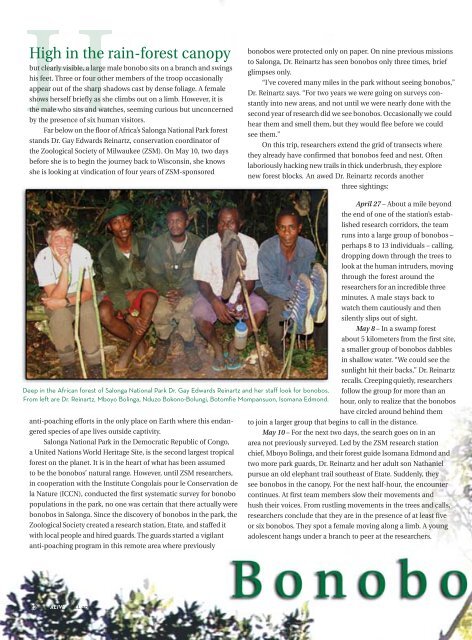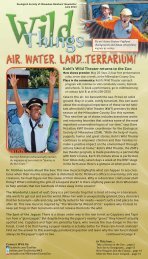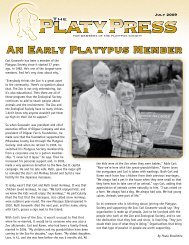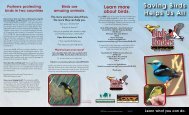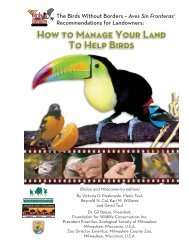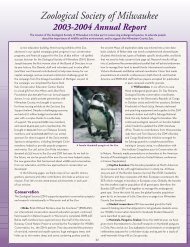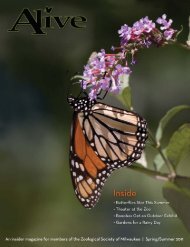AliveFall 2005 - Zoological Society of Milwaukee
AliveFall 2005 - Zoological Society of Milwaukee
AliveFall 2005 - Zoological Society of Milwaukee
You also want an ePaper? Increase the reach of your titles
YUMPU automatically turns print PDFs into web optimized ePapers that Google loves.
High in the rain-forest canopy<br />
but clearly visible, a large male bonobo sits on a branch and swings<br />
his feet. Three or four other members <strong>of</strong> the troop occasionally<br />
appear out <strong>of</strong> the sharp shadows cast by dense foliage. A female<br />
shows herself briefly as she climbs out on a limb. However, it is<br />
the male who sits and watches, seeming curious but unconcerned<br />
by the presence <strong>of</strong> six human visitors.<br />
Far below on the floor <strong>of</strong> Africa’s Salonga National Park forest<br />
stands Dr. Gay Edwards Reinartz, conservation coordinator <strong>of</strong><br />
the <strong>Zoological</strong> <strong>Society</strong> <strong>of</strong> <strong>Milwaukee</strong> (ZSM). On May 10, two days<br />
before she is to begin the journey back to Wisconsin, she knows<br />
she is looking at vindication <strong>of</strong> four years <strong>of</strong> ZSM-sponsored<br />
Deep in the African forest <strong>of</strong> Salonga National Park Dr. Gay Edwards Reinartz and her staff look for bonobos.<br />
From left are Dr. Reinartz, Mboyo Bolinga, Nduzo Bokono-Bolungi, Botomfie Mompansuon, Isomana Edmond.<br />
anti-poaching efforts in the only place on Earth where this endangered<br />
species <strong>of</strong> ape lives outside captivity.<br />
Salonga National Park in the Democratic Republic <strong>of</strong> Congo,<br />
a United Nations World Heritage Site, is the second largest tropical<br />
forest on the planet. It is in the heart <strong>of</strong> what has been assumed<br />
to be the bonobos’ natural range. However, until ZSM researchers,<br />
in cooperation with the Institute Congolais pour le Conservation de<br />
la Nature (ICCN), conducted the first systematic survey for bonobo<br />
populations in the park, no one was certain that there actually were<br />
bonobos in Salonga. Since the discovery <strong>of</strong> bonobos in the park, the<br />
<strong>Zoological</strong> <strong>Society</strong> created a research station, Etate, and staffed it<br />
with local people and hired guards. The guards started a vigilant<br />
anti-poaching program in this remote area where previously<br />
22 ALIVE FALL <strong>2005</strong><br />
bonobos were protected only on paper. On nine previous missions<br />
to Salonga, Dr. Reinartz has seen bonobos only three times, brief<br />
glimpses only.<br />
“I’ve covered many miles in the park without seeing bonobos,”<br />
Dr. Reinartz says. “For two years we were going on surveys constantly<br />
into new areas, and not until we were nearly done with the<br />
second year <strong>of</strong> research did we see bonobos. Occasionally we could<br />
hear them and smell them, but they would flee before we could<br />
see them.”<br />
On this trip, researchers extend the grid <strong>of</strong> transects where<br />
they already have confirmed that bonobos feed and nest. Often<br />
laboriously hacking new trails in thick underbrush, they explore<br />
new forest blocks. An awed Dr. Reinartz records another<br />
three sightings:<br />
April 27 – About a mile beyond<br />
the end <strong>of</strong> one <strong>of</strong> the station’s established<br />
research corridors, the team<br />
runs into a large group <strong>of</strong> bonobos –<br />
perhaps 8 to 13 individuals – calling,<br />
dropping down through the trees to<br />
look at the human intruders, moving<br />
through the forest around the<br />
researchers for an incredible three<br />
minutes. A male stays back to<br />
watch them cautiously and then<br />
silently slips out <strong>of</strong> sight.<br />
May 8 – In a swamp forest<br />
about 5 kilometers from the first site,<br />
a smaller group <strong>of</strong> bonobos dabbles<br />
in shallow water. “We could see the<br />
sunlight hit their backs,” Dr. Reinartz<br />
recalls. Creeping quietly, researchers<br />
follow the group for more than an<br />
hour, only to realize that the bonobos<br />
have circled around behind them<br />
to join a larger group that begins to call in the distance.<br />
May 10 – For the next two days, the search goes on in an<br />
area not previously surveyed. Led by the ZSM research station<br />
chief, Mboyo Bolinga, and their forest guide Isomana Edmond and<br />
two more park guards, Dr. Reinartz and her adult son Nathaniel<br />
pursue an old elephant trail southeast <strong>of</strong> Etate. Suddenly, they<br />
see bonobos in the canopy. For the next half-hour, the encounter<br />
continues. At first team members slow their movements and<br />
hush their voices. From rustling movements in the trees and calls,<br />
researchers conclude that they are in the presence <strong>of</strong> at least five<br />
or six bonobos. They spot a female moving along a limb. A young<br />
adolescent hangs under a branch to peer at the researchers.


